Installation and the painted environment --
or how I grew to love large paintings in small spaces.
Paintings inhabit space. They define environment. I like to use life size figures to connect with the viewer’s stance. The largeness forces you to confront the painting and deal with it’s physical nature. The viewer enters the painted environment while the painted space extends into the viewer’s space. It’s about the whole body, not just the eyes. Large paintings are intended to be seen up close, not from a distance. When the peripheral vision is engaged and the eyes are in continuous motion, the viewer is absorbed into the aesthetic experience.
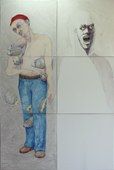
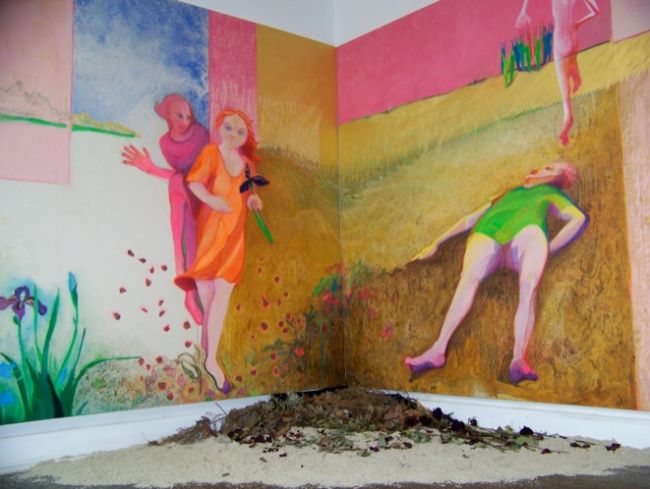
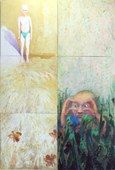
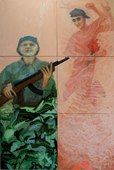
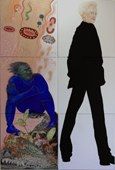
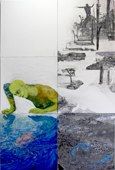
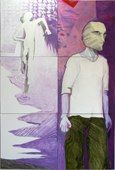
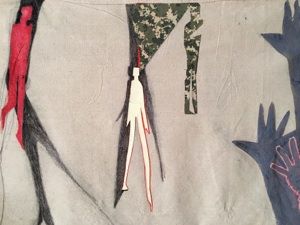
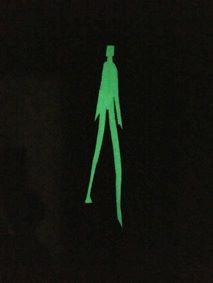
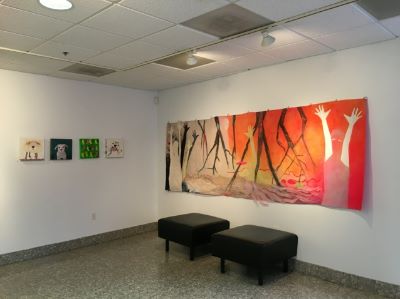
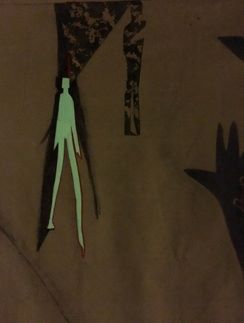
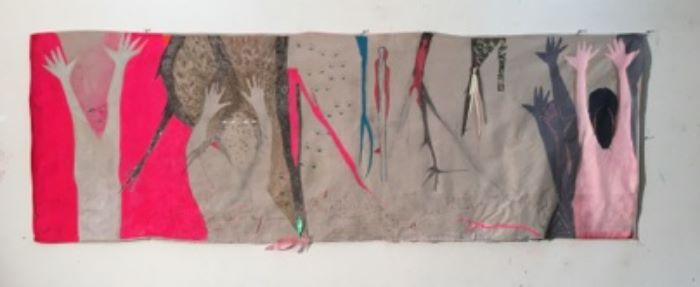
Fold / Unfold
Experience and memory -- I wanted to explore these ideas.
An experience has no beginning and it has no end, it lives in the now.
A painting - a narrative artwork - lives by what the viewer experiences – it happens in the now.
Having experienced the painting, how is the recollection of that experience distorted, even with every intention of retaining its accuracy.
Also the experience shared by viewers has separate and unique versions of the same painted story. What happens between experiencing the painting and the thoughts and dialogue it engenders?
What is revealed, what is obscured, what is overlooked, what is embellished? What is held in memory, and then distorted to become its own separate truth.
Using a 4 x 12 foot drop cloth - unprimed, unstretched - I started to put in shapes and develop a narrative. I was thinking of the Goses, a person’s being at the threshold between life and death. I let the paint soak through the canvas allowing a vestige to appear on the other side. I flipped the canvas and developed the other side. I folded the canvas to share some of the narrative of one side of the story with the recollected narrative on the other sided.
In piecing together these fleeting memories I used spray flourescent paint, acrylic paint, charcoal, Sharpie, and glow-in-the-dark, pieces of screen, cloth, tape, pins, staples, thread….. developing a narrative on one side then on the other side, trying to remember what was done.
The result is a painting that presents a narrative and its recollection. A painted story of obscured and distorted memories that are folded, combined, redefined and pieced together.
The beauty in using the painted language, along with its provocative color and sensual texture, is its randomness. Unlike stories that we read in a structured narrative with a beginning, middle and end, the painted narrative is an indeterminately derived construct. Each time the painting is entered a unique landscape arises. You can enter the picture at anyplace, and in a contrived meanderance travel any path, creating different stories. Engaging a picture in this manner is like taking the written story, separating the pages, putting them in a box, mixing, and then randomly taking pages to read.
The narrative becomes uniquely that of the viewers.
Visual images are reinvented. Like stories we tell and retell, visual images become essential building blocks in defining who we are and illustrating the narrative for the roles we play. The truth lied buries beneath the construct of these experiences, stories and images.
This painting “Virgin Canvas and the Unblessed” is a story about the moral duality inherent on our social paradigm, about the abuse that exists inside bourgeois civility. This duality is both synergistic and parasitic. The tensions generated by their co-existence are manifested through innocence and exploitation, adventurousness and apprehension, promise and tragedy.
As a painter I present a concept, an idea, a narrative.
But first as a painter I make a thing – a physical object.
For this thing, this construct, to be honest, how the paint is used needs to define the concept presented.
Formally the construct of duality is the diptych.
On the left side, “virgin canvas” has an area which is unpainted, untouched. I use soft pastel colors to show the fragility of innocence, an innocence unaware of itself. On the right side, “unblessed”, the paint is mixed with coffee grinds, something sought after and valued for its flavor and aroma, but once tasted it is discarded.
I use the gold paint to suggest otherworldliness.
I interplay geometric and organic shapes to show the objective with the sensual, the calculated with the felt,
planes that push forward, spaces that recede back, places that ask to be inhabited.
However distorted, there is a sense of actuality and place.
I paint large canvases. The action of moving paint on the surface engages my entire body. Viewing large also involves movement, approaching the canvas to see the surface and retreating to see the whole, looking up and looking down. The viewer, through their movement, engages their entire body.
Currently we are living through a deadening of empathy, reflecting aloneness and isolation. Alongside this aloneness and in contrast to it, is the shared experience of looking, a vicarious action. Sitting in darkness in front of the TV or the computer screen, events out of focus, in shadows, in long lines and crowds, talking into boxes, the masses gather with little connection. Ubiquitous looking away has become the social experience replacing interaction.
Looking without interaction and dialogue sharpens that divide us - fundamentalism, imperialism, consumerism, hubris, mix-in duplicity and you breed uncertainty and fear, alienation and anger. I paint.
The Men
72” x 288” painted installation comprised of 36, 24” x 24” canvases